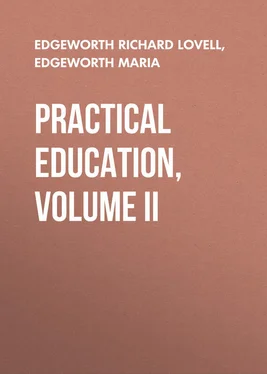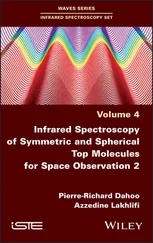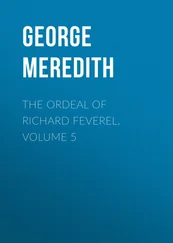Richard Edgeworth - Practical Education, Volume II
Здесь есть возможность читать онлайн «Richard Edgeworth - Practical Education, Volume II» — ознакомительный отрывок электронной книги совершенно бесплатно, а после прочтения отрывка купить полную версию. В некоторых случаях можно слушать аудио, скачать через торрент в формате fb2 и присутствует краткое содержание. Жанр: Прочая научная литература, foreign_edu, foreign_antique, foreign_prose, на английском языке. Описание произведения, (предисловие) а так же отзывы посетителей доступны на портале библиотеки ЛибКат.
- Название:Practical Education, Volume II
- Автор:
- Жанр:
- Год:неизвестен
- ISBN:нет данных
- Рейтинг книги:3 / 5. Голосов: 1
-
Избранное:Добавить в избранное
- Отзывы:
-
Ваша оценка:
- 60
- 1
- 2
- 3
- 4
- 5
Practical Education, Volume II: краткое содержание, описание и аннотация
Предлагаем к чтению аннотацию, описание, краткое содержание или предисловие (зависит от того, что написал сам автор книги «Practical Education, Volume II»). Если вы не нашли необходимую информацию о книге — напишите в комментариях, мы постараемся отыскать её.
Practical Education, Volume II — читать онлайн ознакомительный отрывок
Ниже представлен текст книги, разбитый по страницам. Система сохранения места последней прочитанной страницы, позволяет с удобством читать онлайн бесплатно книгу «Practical Education, Volume II», без необходимости каждый раз заново искать на чём Вы остановились. Поставьте закладку, и сможете в любой момент перейти на страницу, на которой закончили чтение.
Интервал:
Закладка:
Besides the common terms of art, the technical terms of science should, by degrees, be rendered familiar to our pupils. Amongst these the words Space and Time occur, as we have observed, the soonest, and are of the greatest importance. Without exact definitions, or abstract reasonings, a general notion of the use of these terms may be inculcated by employing them frequently in conversation, and by applying them to things and circumstances which occur without preparation, and about which children are interested, or occupied. "There is a great space left between the words in that printing." The child understands, that space in this sentence means white paper between black letters. "You should leave a greater space between the flowers which you are planting" – he knows that you mean more ground . "There is a great space between that boat and the ship" – space of water. "I hope the hawk will not be able to catch that pigeon, there is a great space between them" – space of air. "The men who are pulling that sack of corn into the granary, have raised it through half the space between the door and the ground." A child cannot be at any loss for the meaning of the word space in these or any other practical examples which may occur; but he should also be used to the word space as a technical expression, and then he will not be confused or stopped by a new term when employed in mechanics.
The word time may be used in the same manner upon numberless occasions to express the duration of any movement which is performed by the force of men, or horses, wind, water, or any mechanical power.
"Did the horses in the mill we saw yesterday, go as fast as the horses which are drawing the chaise?" "No, not as fast as the horses go at present on level ground; but they went as fast as the chaise-horses do when they go up hill, or as fast as horses draw a waggon."
"How many times do the sails of that wind-mill go round in a minute? Let us count; I will look at my watch; do you count how often the sails go round; wait until that broken arm is uppermost, and when you say now , I will begin to count the time ; when a minute has past, I will tell you."
After a few trials, this experiment will become easy to a child of eight or nine years old; he may sometimes attend to the watch, and at other times count the turns of the sails; he may easily be made to apply this to a horse-mill, or to a water-mill, a corn-fan, or any machine that has a rotatory motion; he will be entertained with his new employment; he will compare the velocities of different machines; the meaning of this word will be easily added to his vocabulary.
"Does that part of the arms of the wind-mill which is near the axle-tree , or centre , I mean that part which has no cloth or sail upon it, go as fast as the ends of the arms that are the farthest from the centre?"
"No, not near so fast."
"But that part goes as often round in a minute as the rest of the sail."
"Yes, but it does not go as fast."
"How so?"
"It does not go so far round."
"No, it does not. The extremities of the sails go through more space in the same time than the part near the centre."
By conversations like these, the technical meaning of the word velocity may be made quite familiar to a child much younger than what has been mentioned; he may not only comprehend that velocity means time and space considered together, but if he is sufficiently advanced in arithmetic, he may be readily taught how to express and compare in numbers velocities composed of certain portions of time and space. He will not inquire about the abstract meaning of the word space ; he has seen space measured on paper, on timber, on the water, in the air, and he perceives distinctly that it is a term equally applicable to all distances that can exist between objects of any sort, or that he can see, feel, or imagine.
Momentum, a less common word, the meaning of which is not quite so easy to convey to a child, may, by degrees, be explained to him: at every instant he feels the effect of momentum in his own motions, and in the motions of every thing that strikes against him; his feelings and experience require only proper terms to become the subject of his conversation. When he begins to inquire, it is the proper time to instruct him. For instance, a boy of ten years old, who had acquired the meaning of some other terms in science, this morning asked the meaning of the word momentum; he was desired to explain what he thought it meant.
He answered, "Force."
"What do you mean by force?"
"Effort."
"Of what?"
"Of gravity."
"Do you mean that force by which a body is drawn down to the earth?"
"No."
"Would a feather, if it were moving with the greatest conceivable swiftness or velocity, throw down a castle?"
"No." 21 21 When this question was sometime afterwards repeated to S – , he observed, that the feather would throw down the castle, if its swiftness were so great as to make up for its want of weight.
"Would a mountain torn up by the roots, as fabled in Milton, if it moved with the least conceivable velocity, throw down a castle?"
"Yes, I think it would."
The difference between an uniform, and an uniformly accelerated motion, the measure of the velocity of falling bodies, the composition of motions communicated to the same body in different directions at the same time, and the cause of the curvilinear track of projectiles, seem, at first, intricate subjects, and above the capacity of boys of ten or twelve years old; but by short and well-timed lessons, they may be explained without confounding or fatiguing their attention. We tried another experiment whilst this chapter was writing, to determine whether we had asserted too much upon this subject. After a conversation between two boys upon the descent of bodies towards the earth, and upon the measure of the increasing velocity with which they fall, they were desired, with a view to ascertain whether they understood what was said, to invent a machine which should show the difference between an uniform and an accelerated velocity, and in particular to show, by occular demonstration, "that if one body moves in a given time through a given space, with an uniform motion, and if another body moves through the same space in the same time with an uniformly accelerated motion, the uniform motion of the one will be equal to half the accelerated motion of the other." The eldest boy, H – , thirteen years old, invented and executed the following machine for this purpose:
Plate I, Fig. 3. b is a bracket 9 inches by 5, consisting of a back and two sides of hard wood: two inches from the back two slits are made in the sides of the bracket half an inch deep, and an eighth of an inch wide, to receive the two wire pivots of a roller; which roller is composed of a cylinder, three inches long and half an inch diameter; and a cone three inches long and one inch diameter in its largest part or base. The cylinder and cone are not separate, but are turned out of one piece; a string is fastened to the cone at its base a , with a bullet or any other small weight at the other end of it; and another string and weight are fastened to the cylinder at c ; the pivot p of wire is bent into the form of a handle; if the handle is turned either way, the strings will be respectively wound up upon the cone and cylinder; their lengths should now be adjusted, so that when the string on the cone is wound up as far as the cone will permit, the two weights may be at an equal distance from the bottom of the bracket, which bottom we suppose to be parallel with the pivots; the bracket should now be fastened against a wall, at such a height as to let the weights lightly touch the floor when the strings are unwound: silk or bobbin is a proper kind of string for this purpose, as it is woven or plaited, and therefore is not liable to twist. When the strings are wound up to their greatest heights, if the handle be suddenly let go, both the weights will begin to fall at the same moment; but the weight 1, will descend at first but slowly, and will pass through but small space compared with the weight 2. As they descend further, No. 2 still continues to get before No. 1; but after some time, No. 1 begins to overtake No. 2, and at last they come to the ground together. If this machine is required to show exactly the space that a falling body would describe in given times, the cone and cylinder must have grooves cut spirally upon their circumference, to direct the string with precision. To describe these spiral lines, became a new subject of inquiry. The young mechanics were again eager to exert their powers of invention; the eldest invented a machine upon the same principle as that which is used by the best workmen for cutting clock fusees; and it is described in Berthoud. The youngest invented the engine delineated, Plate 1, Fig. 4.
Читать дальшеИнтервал:
Закладка:
Похожие книги на «Practical Education, Volume II»
Представляем Вашему вниманию похожие книги на «Practical Education, Volume II» списком для выбора. Мы отобрали схожую по названию и смыслу литературу в надежде предоставить читателям больше вариантов отыскать новые, интересные, ещё непрочитанные произведения.
Обсуждение, отзывы о книге «Practical Education, Volume II» и просто собственные мнения читателей. Оставьте ваши комментарии, напишите, что Вы думаете о произведении, его смысле или главных героях. Укажите что конкретно понравилось, а что нет, и почему Вы так считаете.












